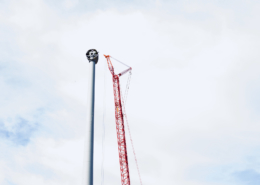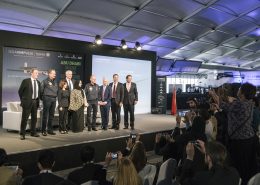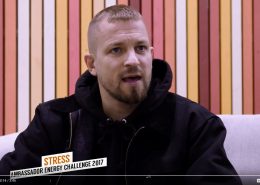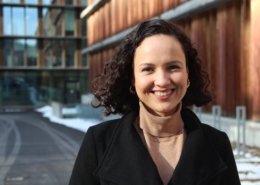André Borschberg was Bertrand Piccard’s co-pilot on Solar Impulse, the first fixed-wing aircraft to fly day and night powered only by solar energy. He and Piccard designed and built the Solar Impulse, aided by a team of engineers and technicians. In July 2016, they completed their flight around the world and showed the potential that solar energy has in the world of aviation. We talked to him about his achievements, ambitions and projects for the future.
Mr Borschberg, why did you become a pilot in the Solar Impulse project?
As you might know, I’ve never been a professional airline pilot, but aviation has always been my true passion and I was especially interested in the pioneering aspect of this project. I have always been fascinated by pioneers and their interest in finding out how to fly. Since I was a young boy, it has been my dream to become a pioneer. As a young man, I was given the chance to join the Swiss Air Force. An air force pilot’s training focuses on the essential and I learned what you have to do in every situation. It not only trained me to become a pilot, it trained me to be a man and a better human being. I am very grateful for all those years I spent in the Swiss Air Force. It meant I was the more experienced pilot in the cockpit and I had the chance to do all the firsts: I was the first to fly at night and the first to fly non-stop over an ocean in Solar Impulse. It was as if I was able to do what the real pioneers did 130 years ago. The dream I had as a small boy came true with this project.
What are the differences between flying a solar aeroplane and a normal aeroplane?
The differences between these two types of aeroplane lies in the potential you have. Imagine you are flying over the Atlantic and the sun is burning down. You know the sun is feeding you energy all the time and you don’t have to stop anywhere to recharge or refuel, you can just keep on going. This gives you a feeling of freedom. With normal aircraft, however, you are not as free. The longer you fly, the more fuel you need, and on top of that, you need fuel to transport that fuel. Another major difference is that a solar aeroplane is rather slower. At the moment, it is not yet possible to go on vacation in a solar aeroplane. It will be another 30 years before we have the first solar jet.
You had some delays during your flight around the world. What was the biggest challenge on your flight and what other problems did you have to face during your journey?
The biggest challenge that we faced on our journey was the unknown. We were trying something that nobody had done before. One of the biggest uncertainties we faced was on the coast of China and Japan, where we had no weather information. You can try to prepare a lot for a journey, but you can be sure that what you haven’t prepared for will happen. This is what makes a journey both exciting and challenging.
How do you think your project has changed the general perception of solar energy and its potential?
The world of aviation has changed a great deal in recent years and using electric power has become an extremely attractive option. When we started 14 years ago with our project, few people thought there was any future for solar energy; now the perception of solar energy has changed a lot. People understand that solar energy is a possible and viable option. People’s perception of solar energy did not change simply because of the Solar Impulse project. But I am extremely pleased to see how much people’s attitudes and awareness has changed.
You completed the flight around the world in the solar aeroplane in July 2016. What comes next?
Bertrand will continue to raise awareness and promote clean technology at a political level. I will continue with my research into solar energy technology. Imagine the potential of solar-powered electric aircraft that can take off vertically and transport people autonomously anywhere in a city. Little or no noise and much cheaper than a helicopter. I’m sure that Switzerland will play an important role in developing this technology. In about ten years’ time, it could be reality. But to achieve it, we not only need to develop the technology, we also need support from all the authorities and institutions involved in this field. Prototypes will be available quite quickly, but it will take time for them to be tested and approved. Swiss politicians have had a similar debate about drones. We will benefit from the outcome of that debate in relation to our aircraft. Electric aeroplanes will probably have to be flown by a pilot first, until we trust the technology enough to let it fly autonomously. It has to be reliable enough and it has to comply with the law. Will the world be ready? I don’t know, but in ten years’ time the need for electric aircraft will be even greater. And I want to develop the technologies needed for these aircraft.
Interview conducted by Selina Zehnder, graduate trainee in the Media and Political Affairs Division, SFOE


 © OFENVisite de chantier au nouveau parc éolien de Sainte-Croix (VD)
© OFENVisite de chantier au nouveau parc éolien de Sainte-Croix (VD)  Mit Piccard in Abu Dhabi
Mit Piccard in Abu Dhabi  Interview mit Stress, Ambassador der Energy Challenge 2017
Interview mit Stress, Ambassador der Energy Challenge 2017  BFEDie Energiewelt entdeckt – Mein Praktikum beim BFE
BFEDie Energiewelt entdeckt – Mein Praktikum beim BFE 


Spannende Geschichte, schade dass es nicht weitergeht, resp. die Politik noch nicht so weit ist, da mehr Unterstützung zu bieten. Aber eben, wenn grosse Player auf der anderen Seite des Atlantiks im Bereich der sauberen Energie wieder im Schnellschuss zurückkrebsen und neue Ölpipelines mit Hochdruck weiterbauen, da hat es die Energie aus dem Weltall noch schwerer.